Top image: US soldier in Anzio stares at a giant portrait of Benito Mussolini, seized from Fascist Party headquarters in the town, used by Allied troops for target practice, February 7, 1944. US Army Signal Corps photo, gift of Ms. Regan Forrester, from the Collection of The National WWII Museum, 2002.337.105.
1944
January 8 Trial in Verona of Count Galeazzo Ciano, Mussolini’s son-in-law and former foreign minister, charged with treason for supporting the ouster of Mussolini the previous July. Ciano is convicted and executed on January 11.
January 13 The decision is made to shift New Zealand troops across the Italian Peninsula from Orsogna to Cassino.
January 17 US Fifth Army undertakes offensive against the Gustav Line, the German line of defense with its fortifications blocking the way to Rome and anchored on Monte Cassino.
January 20 A diversionary attack across the Rapido River is attempted by the US 36th Infantry Division, under the command of Major General Fred Walker. Germans repulse this offensive on January 20-21 and inflict heavy losses on the Americans, who pull back across the river after two days.
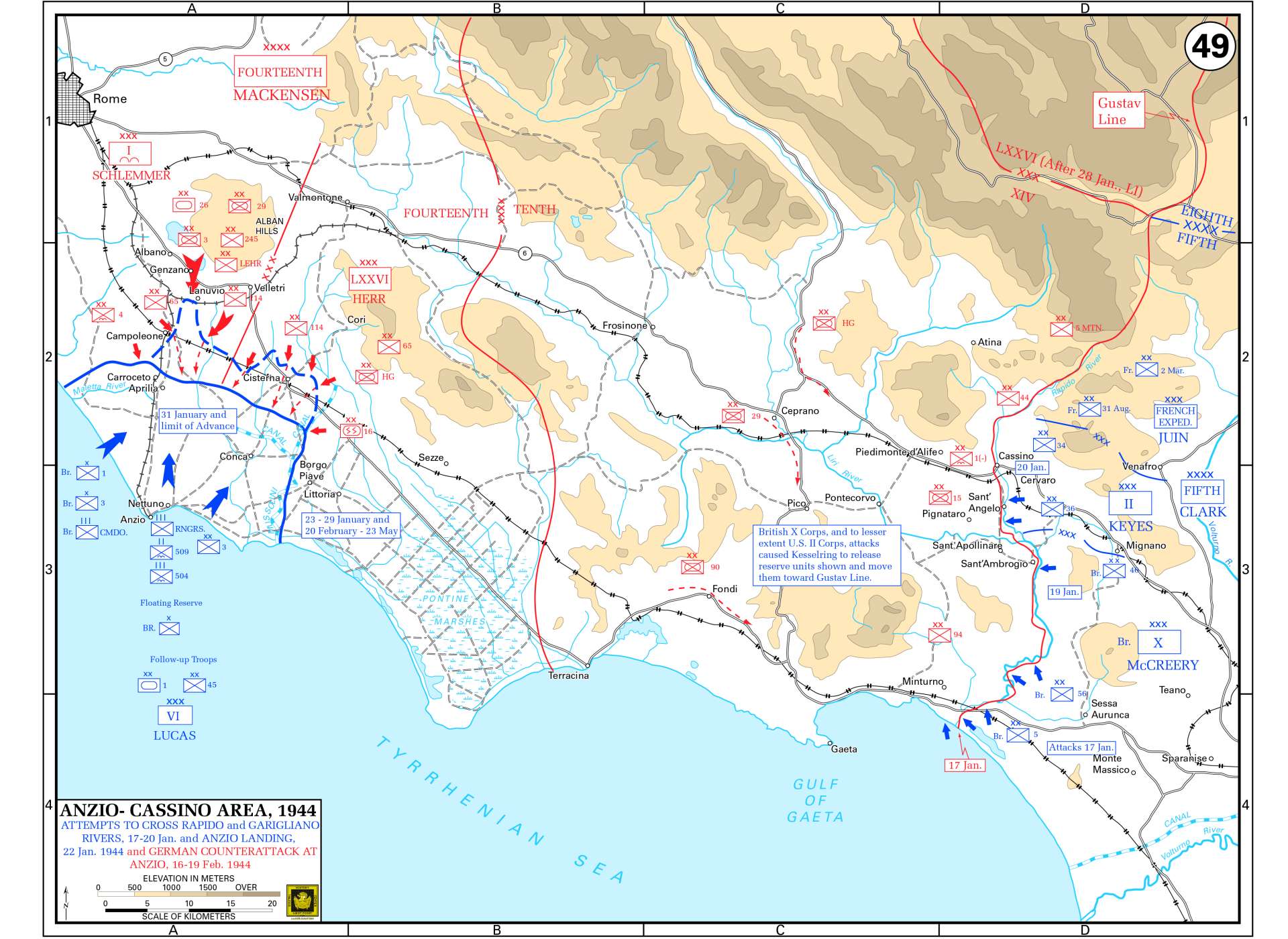
Map of Allied operations in the Anzio-Cassino area in Italy, 1944. Map courtesy of the United States Military Academy Department of History.
January 22 Beginning of Operation Shingle, amphibious operation at the resort town of Anzio, 80 miles behind the Gustav Line and 35 miles from Rome, implemented by US VI Corps, under the command of Major General John P. Lucas. Naval support is provided by Joint US-Royal Navy Task Force 81, led by US Rear Admiral Frank J. Lowry. Allied air forces fly more than 1,200 sorties. More than 36,000 men and 3,000 vehicles land by day’s end, encountering no opposition.
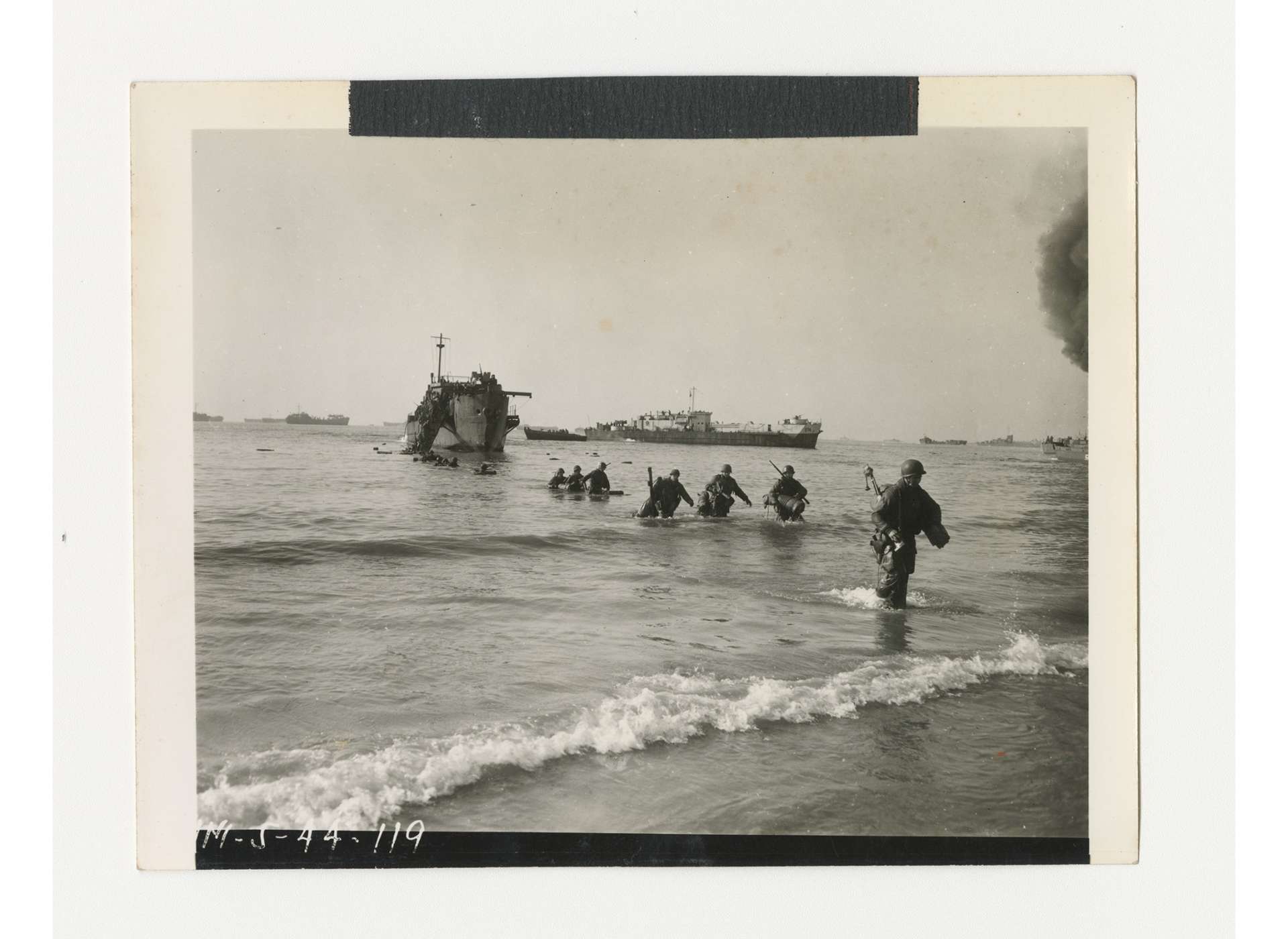
Troops of US Fifth Army come ashore at Anzio, January 23, 1944. Gift of Ms. Regan Forrester, from the Collection of The National WWII Museum, 2002.337.066.
January 24 US 1st Armored Division lands at Anzio to reinforced the US 3rd and 45th Infantry Divisions and the British 1st Infantry Division in the beachhead.
January 25 German forces surround the beachhead at Anzio.
January 28-29 Political parties comprising the CLN meet in Bari and agree to form a council, demand the abdication of Victor Emmanuel III for his complicity in the creation of the Mussolini dictatorship, and the formation of a regency. The CLN does not, however, call for the removal of Badoglio.
January 30 General Lucas, now with 69,000 men, launches an offensive to break out of the Anzio beachhead. Lucas’s offensive fails.
February 3 First German counter-attack at Anzio.
February 5 Leone Ginzburg, longtime anti-fascist (a member of the moderate socialist Justice and Liberty group), editor and translator, and a Jew who had lost his citizenship when Mussolini enacted antisemitic legislation in 1938, succumbs to the effects of torture in the German section of the jail in Rome.
February 15-18 Allies bomb Monte Cassino. The venerated Benedictine abbey there, dating to the sixth century CE, is demolished.
February 16 Operation Fish Haul, the second German counter-attack at Anzio, starts, intending to split the Allied beachhead at Anzio.
February 17 28th Maori Battalion crosses the Rapido River south of Cassino and captures the railway station. It is forced to withdraw the following day when the Germans counter-attack.
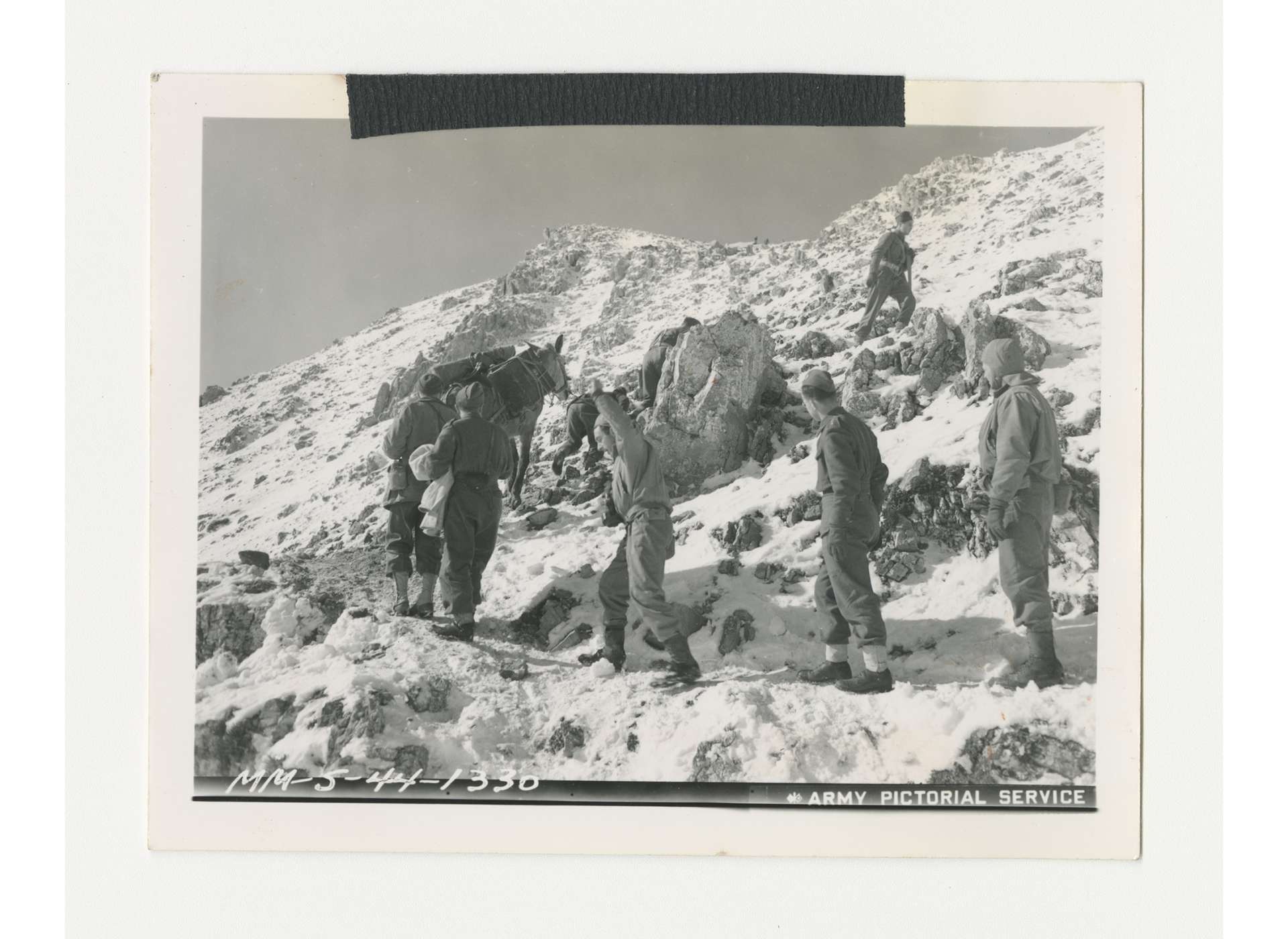
Members of the Polish Carpathian Division with pack mule navigate a mountainous area, February 18, 1944. US Army Signal Corps photo, gift of Ms. Regan Forrester, from the Collection of The National WWII Museum, 2002.337.123.
February 20-25 A series of strategic bombing raids by the US Army Air Forces and the British Royal Air Force (RAF) Bomber Command, known as “Big Week,” are launched against key elements of the German aircraft industry and to lure the Luftwaffe’s fighter force into battle. From Italy, Fifteenth Air Force contributes to “Big Week” over Germany and that spring plays a decisive role in dramatically reducing production capacity at the massive oil refinery complex at Ploesti, Romania.
March 8 Badoglio persuades the USSR to recognize his government.
March 15 New Zealand Corps attacks Cassino town but has to withdraw on the 23rd.
March 17 Maurizio Giglio, a member of the Fascist police working as a double agent for the American Office of Strategic Services (OSS), is arrested by the Fascist Special Police Unit, headed by Pietro Koch.
March 18 Mount Vesuvius erupts, destroying over a period of weeks some 80 aircraft of the US Twelfth Air Force, displacing thousands of people in the Allied zone of occupation, and covering the surrounding area with ash. Life magazine reports that the night sky is illuminated from the Gulf of Naples to the Anzio beachhead.
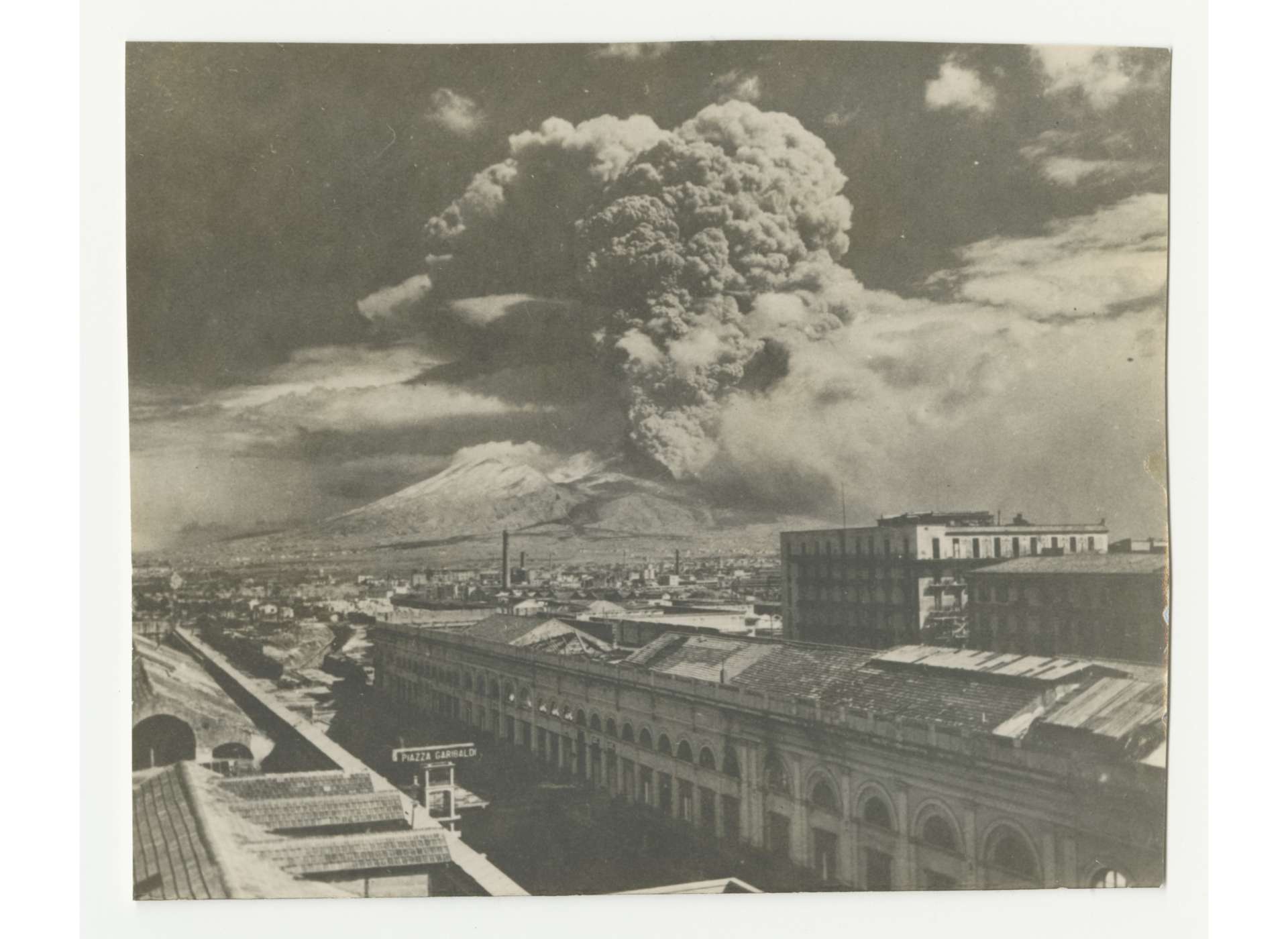
Mount Vesuvius erupts near Naples, Spring 1944. Gift of Melissa Bourne, from the Collection of The National WWII Museum, 2009.214.044.
March 23 Via Rasella attack by 10 Communist partisans, including Carla Capponi and Rosario Bentivegna, kills 33 members of a company of a SS battalion with a homemade bomb, grenades, and gunfire in the historic center of Rome. The attack took place on the twenty-fifth anniversary of the founding of Mussolini’s Fascist organization in Milan. Hitler calls for retribution that will “make the world tremble.”
March 24 Fosse Ardeatine (Ardeatine Caves) Massacre conducted by SD chief Herbert Kappler in retaliation for the Via Rasella attack. 335 political prisoners and civilians, men and teenage boys, 75 of them Jews, are shot in groups of five in these old caves on the outskirts of Rome. None of them have any connection to the attack on the SS battalion. Kappler entrusts the killing to two of his subordinates, Karl Hass and Erich Priebke. Field Marshal Kesselring supported the reprisal.
March 27 Palmiro Togliatti, leader of Communist Party of Italy, arrives in Naples from the Soviet Union. Five days later, he gives a speech, known as the “Salerno Turn,” calling for the Communists to support the Badoglio government and commit to a parliamentary path to power.
April 1 Bread riots occur in Rome.
April 2 Trial by the Fascists in Turin of General Giuseppe Perotti and comrades in the Piedmontese Military Command, a partisan organization. They are convicted and executed on April 5.
April 12 After pressure from Allied representatives, Victor Emmanuel III announces that a lieutenancy for Italy would begin after Rome’s liberation and would be entrusted to his son Umberto.
April 15 Communist partisans, led by Bruno Fanciullacci, kill Giovanni Gentile (Fascist political philosopher and former minister of education in the Fascist regime) in Florence.
April 16 South African 6th Armored Division lands at Taranto. It will be put under Canadian command in late May until placed under American command in late August for the remainder of the war.
April 21 All of the US 88th Infantry Division arrives in Italy.
April 22 Badoglio creates a new, national unity government that includes representatives from the six political parties comprising the CLN.
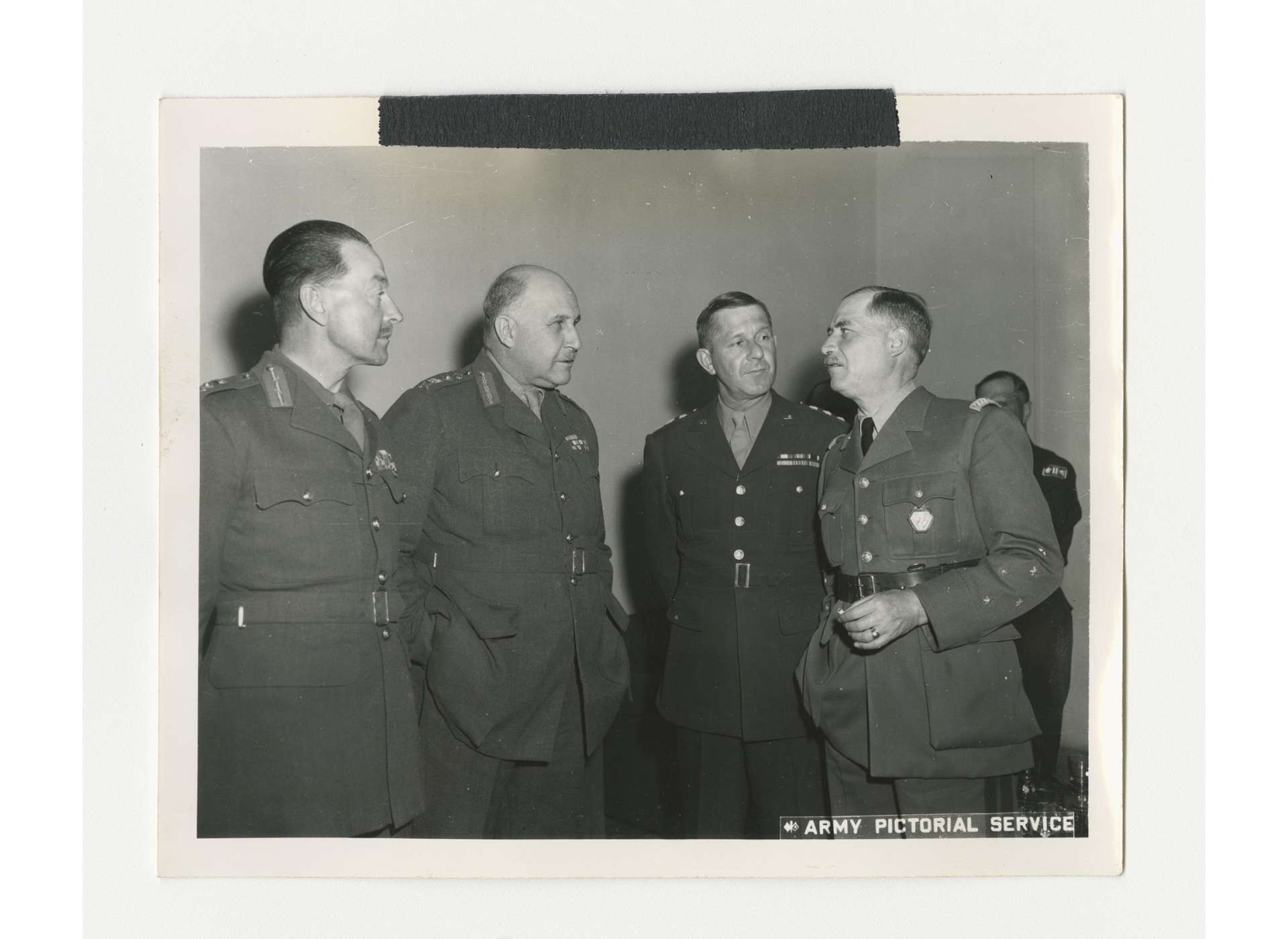
Meeting between, from left to right, British General Sir Harold Alexander, Commander in Chief of Allied Armies in Italy, British General Sir Henry Maitland Wilson, Supreme Allied Commander, Mediterranean Theater, US Lieutenant General Jacob Devers, Deputy Supreme Commander, Mediterranean Theater, and General Alphonse Juin, Commander of the Free French Expeditionary Corps, April 25, 1944. US Army Signal Corps photo, gift from Ms. Regan Forrester, from the Collection of The National WWII Museum, 2002.337.505.
May 11-12 Allied armies, heavily reinforced, launch a huge new offensive against the Gustav Line—Operation Diadem. The French Expeditionary Force, part of General Mark Clark’s Fifth Army, plays a key role.
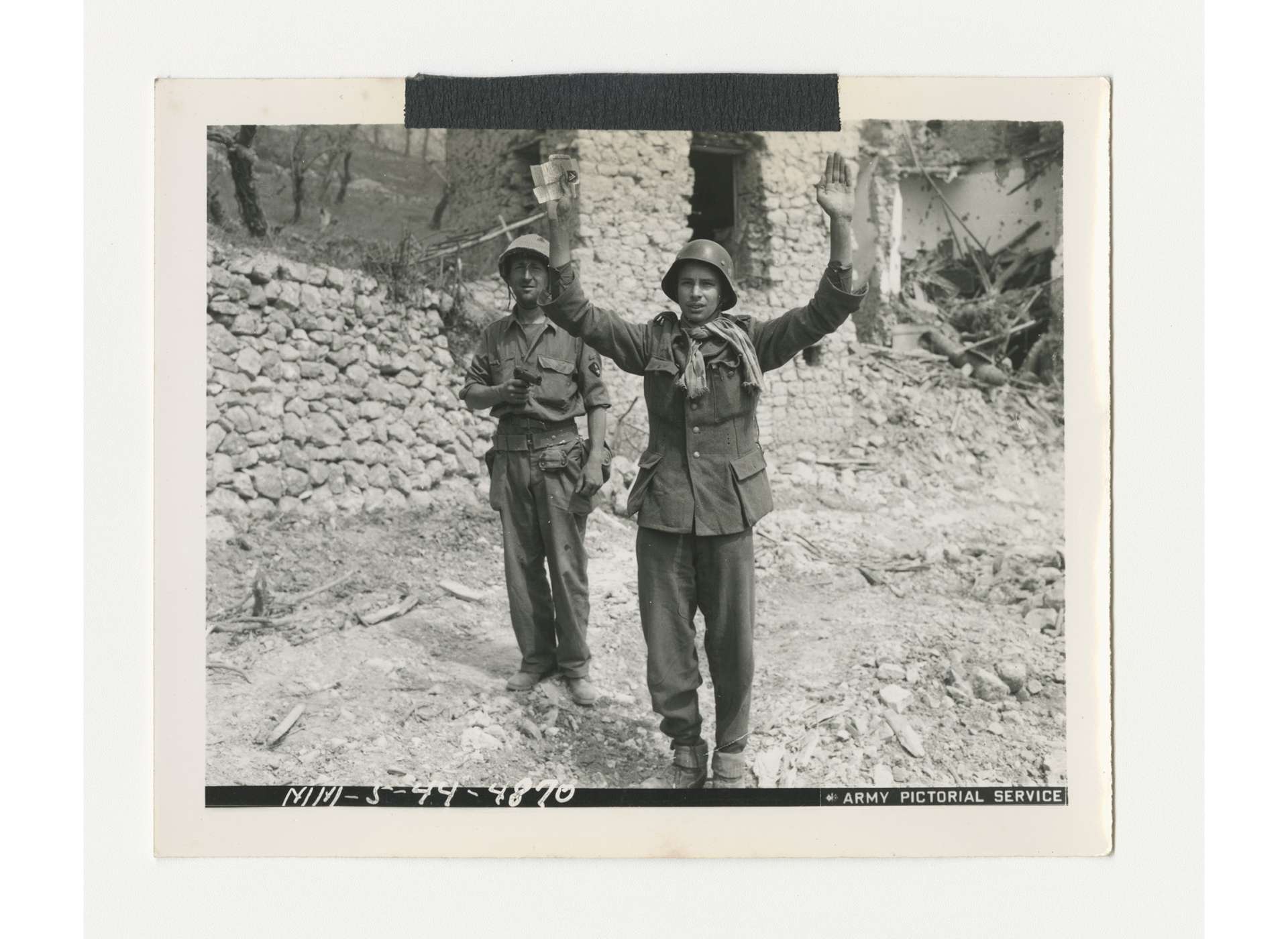
Moroccan soldier, part of Free French forces, guards a German prisoner of war in the Castelforte area, May 15, 1944. US Army Signal Corps photo, gift of Ms. Regan Forrester, from the Collection of The National WWII Museum, 2002.337.187.
May 18 Troops from General Władysław Anders’s Polish II Corps, part of Eighth Army, seize Monte Cassino.
May 23 Allied forces at Anzio undertake a breakout offensive, linking up with troops coming up from Cassino.
May 25 British General Sir Harold Alexander, commander of all Allied forces in Italy, orders Clark to cut off Germans retreating north to the Caesar Line, an unfinished line of defense stretching eastward from the area between Anzio and Rome to just north Valmontone. Clark rejects Alexander’s notion that capturing Rome is of secondary importance and he believes that the Caesar Line was too strong for US VI Corps, under the command of Major General Lucian K. Truscott, Jr., to take. Clark decides to move VI Corps toward the capital instead, allows the bulk of German forces to escape.
May 28 The US 442nd Infantry Regiment (Nisei) arrives in Italy and is placed under the US 34th Infantry Division.
June 2 With Allied forces nearing Rome, Pope Pius XII declares over the radio that “Whosoever raises his hand against Rome will be guilty of matricide before the civilized world and the eternal judgment of God.”
June 5 Following the German evacuation of the city, Allied troops, under the command of General Mark Clark, enter Rome in the afternoon, liberating the ancient city. It is the first capital of the Axis Powers to fall. Thousands cheer Clark’s men and shower them with flowers. Addressing a crowd of some 100,000 people, Pope Pius XII thanks the Germans and the Allies for their restraint and calls for the populace to not seek vengeance. Kesselring’s forces stage a fighting retreat north to the Arno River where they will prepare a new defense at the Gothic Line, 90 miles north of Rome, stretching from the Tyrrhenian coast between Pisa and La Spezia to the Adriatic coast between Pesaro and Rimini. The Apennine Mountains will serve the German defenses well.
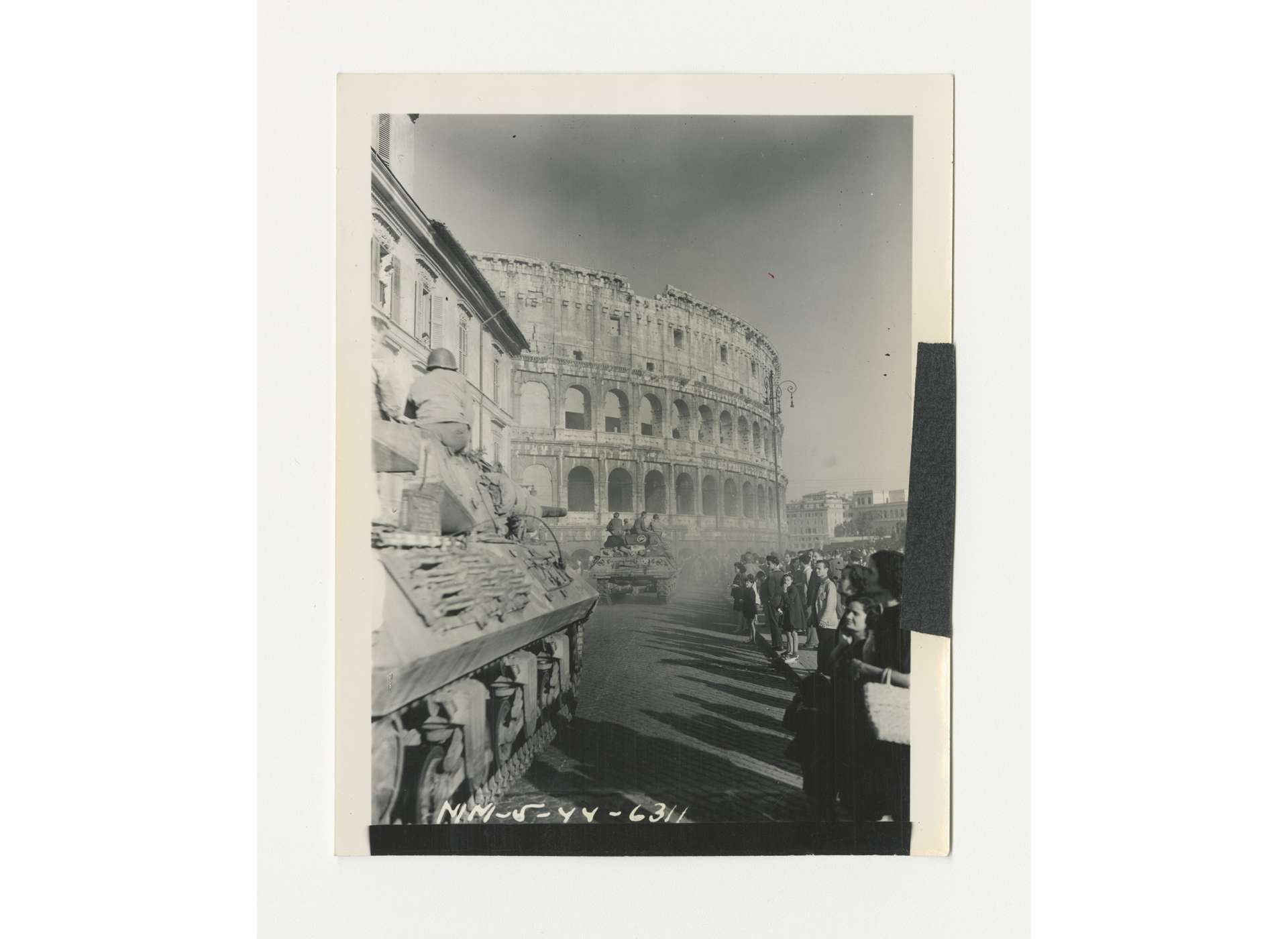
Men and tanks of the US 1st Armored Division, Fifth Army, stream by the Colosseum in Rome, June 5, 1944. US Army Signal Corps photo, gift of Ms. Regan Forrester, from the Collection of The National WWII Museum, 2002.337.624.
June 6 Italian Communist Party leader Togliatti calls for Communist-affiliated partisans to create CLN power locally but refrain from “imposing changes in a socialist or communist sense.”
June 7 General Alexander calls for the Italian people to rise up against the Germans.
June 8 Badoglio resigns following political crisis and is replaced as prime minister by Ivanoe Bonomi, a moderate socialist.
June 9 The CLNAI sets up military groups in northern Italy, called Freedom Volunteers.
June 17 Field Marshal Kesselring issues a decree holding the Italian population responsible for acts of resistance against the Germans.
June 29 German troops kill 212 people in the villages of Civitella della Chiana, Gebbia, Cornia, Burrone, and San Pancrazio in Tuscany during a reprisal for partisan attacks.
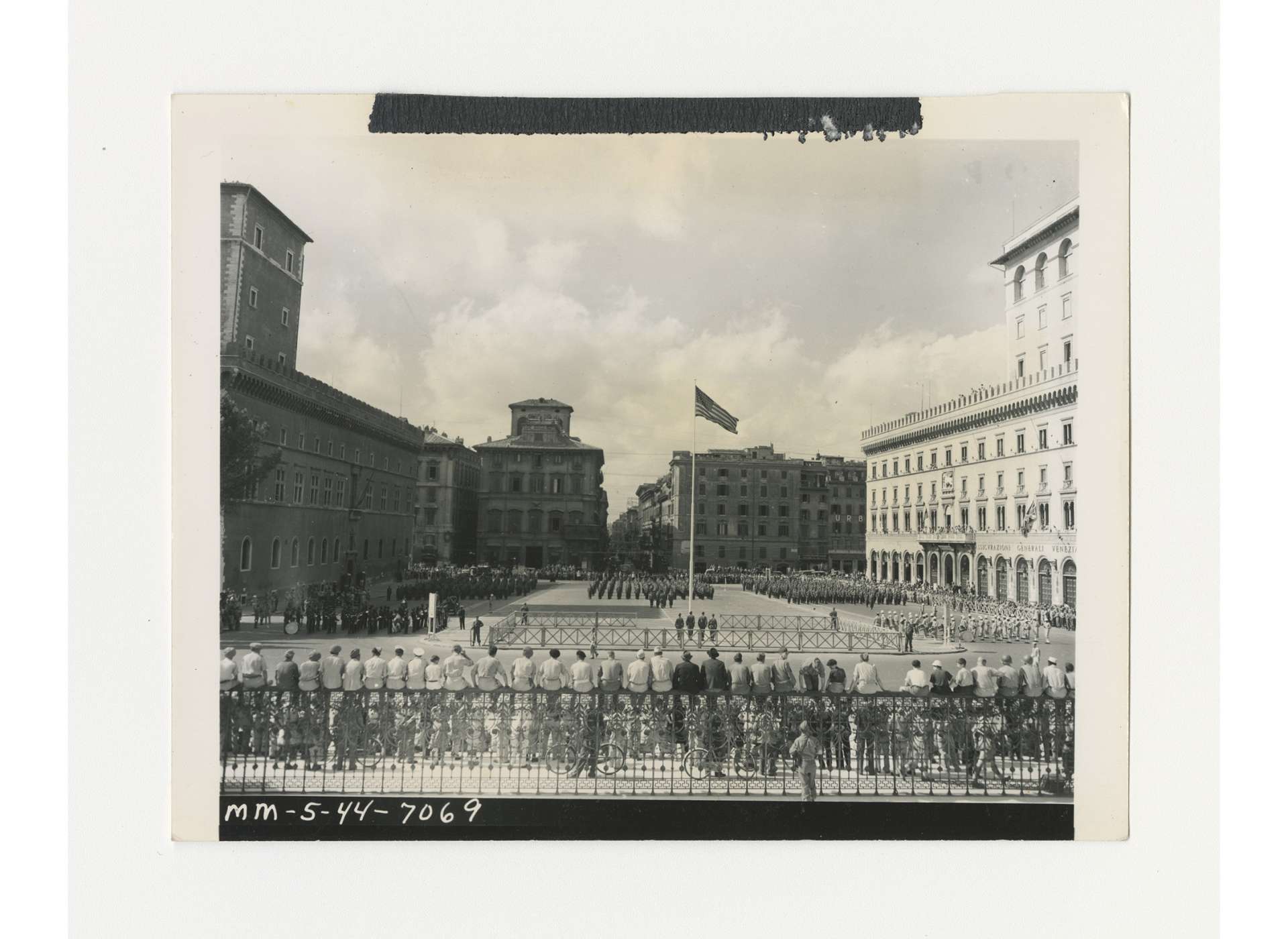
Troops of US 2nd Battalion, 338th Infantry Regiment, 85th Infantry Division, gather in the Piazza Venezia in Rome for an Independence Day retreat ceremony to lower the American flag flying over Rome. The flag had flown over the White House on December 7, 1941. US Army Signal Corps photo, gift of Ms. Regan Forrester, from the Collection of The National WWII Museum, 2002.337.658.
July 16 Battle for Florence begins.
July 24 Due to the large number of Allied aircrews downed over Yugoslavia, the Office of Strategic Services and Fifteenth Air Force create the Air Crew Rescue Unit that will work with Yugoslav partisans and the Chetniks to rescue more than 500 Allied and US crewmembers before the end of the war.
August 4 South African troops cross the Ponte Vecchio, a bridge left intact by the Germans, and enter Florence. German troops completely abandon the city a week later.
August 12 The 16th SS Panzergrenadier Division “Reichsführer SS” massacres 560 civilians, including more than 130 children, at Sant’Anna di Stazzema in Tuscany, likely as a reprisal for a partisan assault on the unit four days earlier.
August 15 Operation Dragoon, the amphibious operation in southern France, required the withdrawal of General Lucien K. Truscott’s US VI Corps and the French Expeditionary Corps. The departure of Truscott’s corps, consisting of the US 3rd, 36th, and 45th Infantry Divisions, is partially offset by the arrival of the Brazilian Expeditionary Force and the US 92nd Infantry Division (“Buffalo Soldiers”).
September 8 Partisans liberate Domodossola, near the Swiss border. German and Italian forces withdraw after a cease-fire and the Ossola Republic is proclaimed on September 10.
September 15 About 5,000 members of the Brazilian Expeditionary Force under the command of General Euclides Zenóbio da Costa, see their first combat against the Germans near Vareggio, north of Pisa.
September 29 In Marzabotto, near Bologna, men of the 16th SS Panzergrenadier Division “Reichsführer SS”, carry out a reprisal against civilians. By October 6, more than 1,800 people are murdered.
October 9-14 The Ossola Republic is suppressed by German and Italian Fascist forces.
October 20 The South African 6th Armored Division drives back a counter-attack by German armored units at Monte Salvaro and gets to Monte Alcino. The US 88th Infantry Division reaches Farneto. The 4th Division of the British 8th Army crosses the Cesano River, even though the Germans demolished the bridge. Allied forces seize Cesenatico on the Adriatic, where the US Twelfth Air Force will set up airfields.
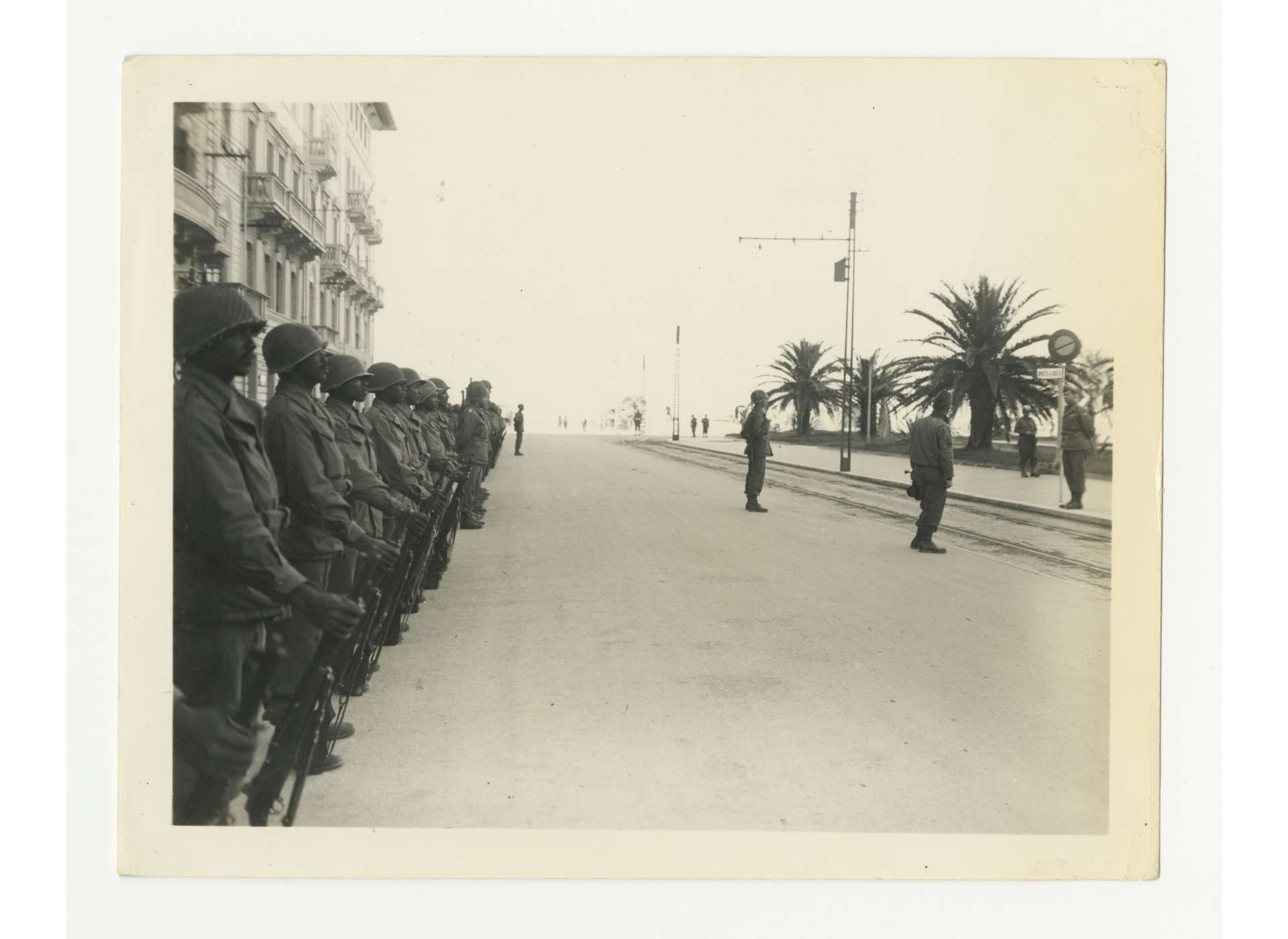
African-American soldiers of the 92nd Infantry Division, 370th Regimental Combat Team stand at attention while Lt. General Mark Clark speaks to them during a decoration ceremony, Via Reggio area, October 20, 1944. US Army Signal Corps photo, gift in memory of William F. Caddell, Sr., from the Collection of The National WWII Museum, 2007.048.337.
October 23 German Field Marshal Kesselring is severely injured during a car accident. General Heinrich von Vietinghoff assumes command of all German forces in Italy until January 15, 1944.
November 13 General Alexander sends a message to partisans stating that the summer offensive is over and telling them to go back to their homes for the winter of 1944-45. Luigi Longo from the Communist Party of Italy, speaking for the Volunteer Corps for Freedom, says in response that the partisans will not abandon their posts.
November 15 Men of the 8th Indian Division (under US command) link up with forces of the Polish II Corps (under British command). A general strike shakes the city of Turin, taking the Germans aback.
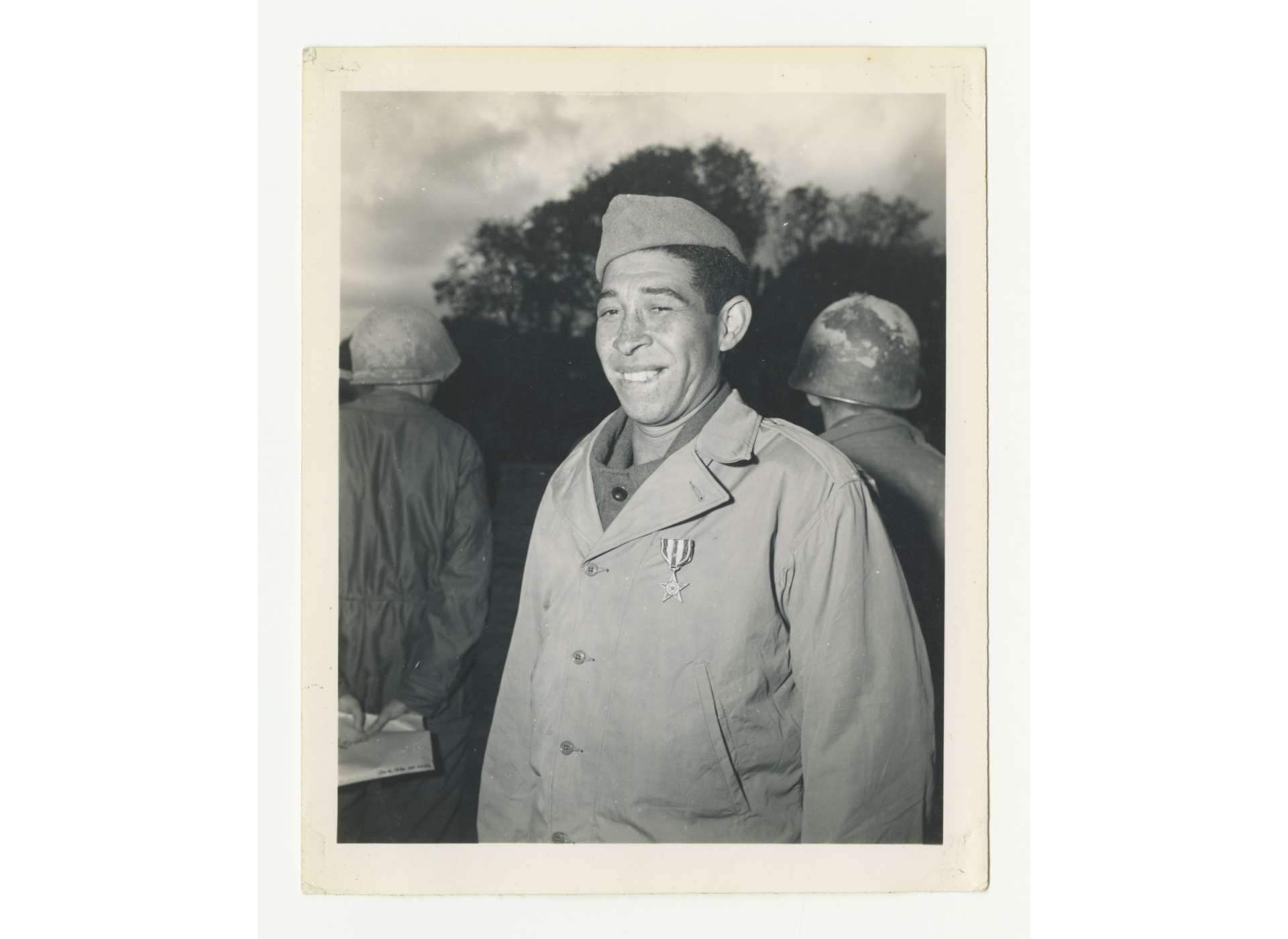
Marcilio Juiz Pinto, a member of the Brazilian Expeditionary Force from Sao Paulo, Brazil, after he received the Silver Star from Lt. General Mark Clark, commander of US Fifth Army, November 16, 1944. US Army Signal Corps photograph, gift in memory of William F. Cadddell, Sr., from the Collection of The National WWII Museum, 2007.048.480.
December 3 British Eighth Army starts its offensive, the goal to take Bologna. General Anders’s Polish II Corps on the left, V Corps in the center, and Canadian I Corps on the Adriatic.
December 4 Polish troops take Montecchio and Canadian troops move into Ravenna.
December 6 Mussolini gives his final speech in Milan.
December 7 The Rome Protocols signed by Allied representatives and the CLNAI. The CLNAI agrees to follow orders given by the Allied Powers, recognizes the Bonomi government as the Italian government, and promises to maintain order in northern Italy until an Allied military occupation is devised. A similar agreement is reached between the Allies and the Bonomi government on December 26.
December 16 General Sir Harold Alexander is promoted to Field Marshal and becomes Supreme Allied Commander, Mediterranean. General Clark is promoted to Commander-in-Chief of Allied forces in Italy (Fifteenth Army Group), while General Lucian K. Truscott is appointed to command of US Fifth Army.
December 20-21 Polish and Canadian troops completely drive the Germans across the Senio River.
December 26 German and Italian Fascist forces launch Operation Winter Storm, directed primarily against the 92nd Infantry Division. General Willis D. Crittenberger, commander of IV Corps, US Fifth Army, rushes in reinforcements and the Axis troops are forced to withdraw to their original lines.
December 31 General Sir Richard McCreery assumes command of the British Eighth Army.
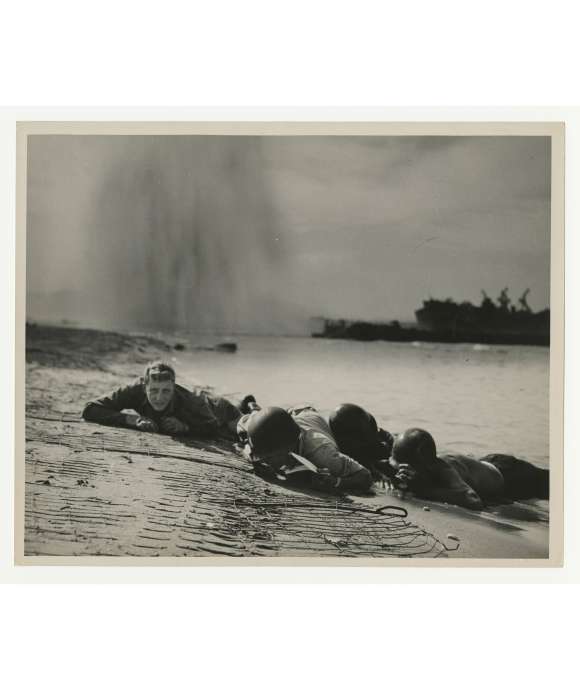
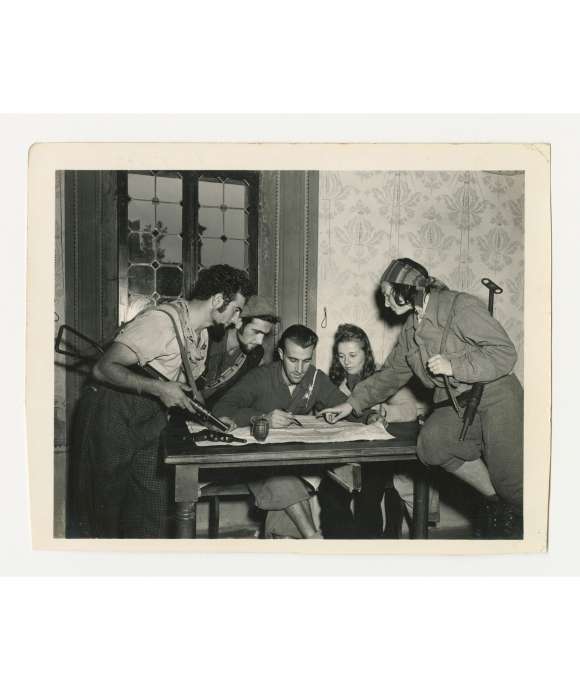
The Allied Campaign in Italy, 1943-45: A Timeline, Part Three
January 1, 1945–May 8, 1945 (V-E Day)
Jason Dawsey, PhD
Jason Dawsey, PhD, is ASU WWII Studies Consultant in the Jenny Craig Institute for the Study of War and Democracy.
Cite this article:
MLA Citation:
APA Citation:
Chicago Style Citation:
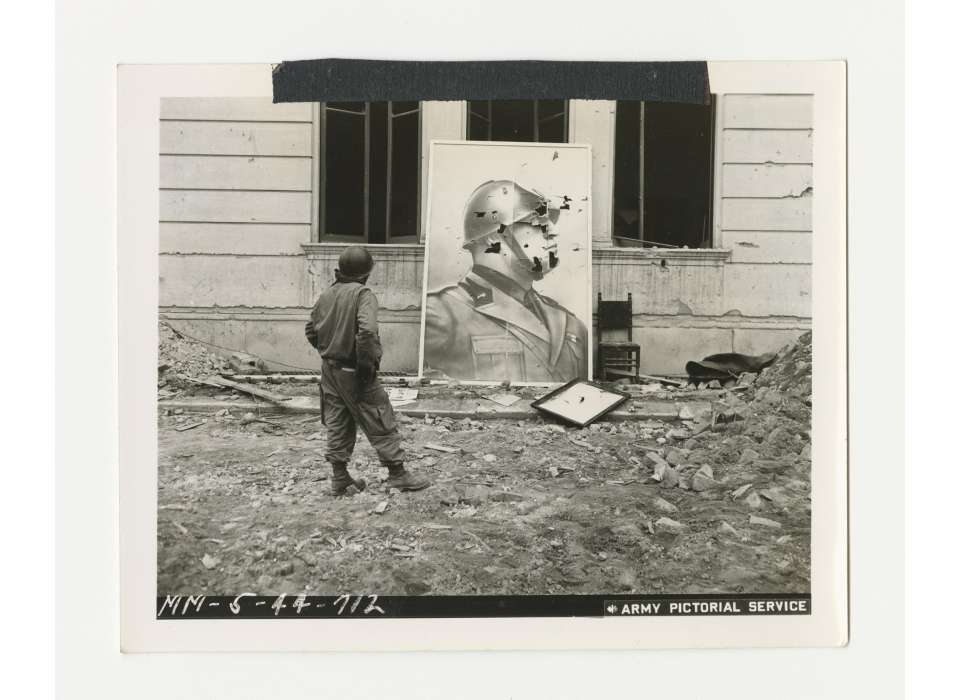




![Max Fuchs, New York City cantor, sings as Rabbi Sydney [sic] Lefkowitz, Richmond, VA, conducts the first Jewish services from Germany.](/sites/default/files/styles/max_650x650/public/2025-10/image1.jpg)



